Amazon rainforest
| Amazon rainforest Portuguese: Floresta amazônica Spanish: Selva amazónica Dutch: Amazoneregenwoud | |
|---|---|
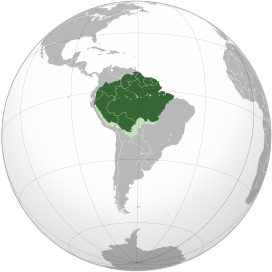 Map of the Amazon rainforest ecoregions as delineated by the WWF in dark green[1] and the Amazon drainage basin in light green. | |
| Geography | |
| Location | Bolivia, Brazil, Colombia, Ecuador, French Guiana (France), Guyana, Peru, Suriname, and Venezuela |
| Coordinates | 3°S 60°W / 3°S 60°W |
| Area | 5,500,000 km2 (2,100,000 sq mi) |
The Amazon rainforest,[a] also called Amazon jungle or Amazonia, is a moist broadleaf tropical rainforest in the Amazon biome that covers most of the Amazon basin of South America. This basin encompasses 7,000,000 km2 (2,700,000 sq mi),[2] of which 5,500,000 km2 (2,100,000 sq mi) are covered by the rainforest. This region includes territory belonging to nine nations and 3,344 formally acknowledged indigenous territories.
The majority of the forest, 60%, is in
More than 30 million people of 350 different ethnic groups live in the Amazon, which are subdivided into 9 different national political systems and 3,344 formally acknowledged indigenous territories. Indigenous peoples make up 9% of the total population, and 60 of the groups remain largely isolated.[5]
Large scale deforestation is occurring in the forest, creating different harmful effects. Economic losses due to deforestation in Brazil could be approximately 7 times higher in comparison to the cost of all commodities produced through deforestation. In 2023, the World Bank published a report proposing a non-deforestation based economic program in the region.[6][7]
Etymology
The name Amazon is said to arise from a war
History




Based on archaeological evidence from an excavation at Caverna da Pedra Pintada, human inhabitants first settled in the Amazon region at least 11,200 years ago.[10] Subsequent development led to late-prehistoric settlements along the periphery of the forest by AD 1250, which induced alterations in the forest cover.[11]
For a long time, it was thought that the Amazon rainforest was never more than sparsely populated, as it was impossible to sustain a large population through agriculture given the poor soil. Archeologist Betty Meggers was a prominent proponent of this idea, as described in her book Amazonia: Man and Culture in a Counterfeit Paradise. She claimed that a population density of 0.2 inhabitants per square kilometre (0.52/sq mi) is the maximum that can be sustained in the rainforest through hunting, with agriculture needed to host a larger population.[12] However, recent anthropological findings have suggested that the region was actually densely populated. The Upano Valley sites in present-day eastern Ecuador predate all known complex Amazonian societies.[13]
Some 5 million people may have lived in the Amazon region in AD 1500, divided between dense coastal settlements, such as that at Marajó, and inland dwellers.[14] Based on projections of food production, one estimate suggests over 8 million people living in the Amazon in 1492.[15] By 1900, the native indigenous population had fallen to 1 million and by the early 1980s it was less than 200,000.[14]
The first European to travel the length of the
Since the 1970s, numerous geoglyphs have been discovered on deforested land dating between AD 1–1250, furthering claims about Pre-Columbian civilizations.[18][19] Ondemar Dias is accredited with first discovering the geoglyphs in 1977, and Alceu Ranzi is credited with furthering their discovery after flying over Acre.[17][20] The BBC's Unnatural Histories presented evidence that the Amazon rainforest, rather than being a pristine wilderness, has been shaped by man for at least 11,000 years through practices such as forest gardening and terra preta.[17] Terra preta is found over large areas in the Amazon forest; and is now widely accepted as a product of indigenous soil management. The development of this fertile soil allowed agriculture and silviculture in the previously hostile environment; meaning that large portions of the Amazon rainforest are probably the result of centuries of human management, rather than naturally occurring as has previously been supposed.[21] In the region of the Xingu tribe, remains of some of these large settlements in the middle of the Amazon forest were found in 2003 by Michael Heckenberger and colleagues of the University of Florida. Among those were evidence of roads, bridges and large plazas.[22]
In the Amazonas, there has been fighting and wars between the neighboring tribes of the
The Munduruku were a warlike tribe that expanded along the Tapajós river and its tributaries and were feared by neighboring tribes. In the early 19th century, the Munduruku were pacified and subjugated by the Brazilians.[25]
During the
In the 1950s, Brazilian explorer and defender of indigenous people,
In 1961, British explorer Richard Mason was killed by an uncontacted Amazon tribe known as the Panará.[28]
The Matsés made their first permanent contact with the outside world in 1969. Before that date, they were effectively at-war with the Peruvian government.[29]
Geography
Location
Nine countries share the Amazon basin—most of the rainforest, 58.4%, is contained within the borders of Brazil. The other eight countries are Peru with 12.8%, Bolivia with 7.7%, Colombia with 7.1%, Venezuela with 6.1%, Guyana with 3.1%, Suriname with 2.5%, French Guiana with 1.4% and Ecuador with 1%.[30]
Natural
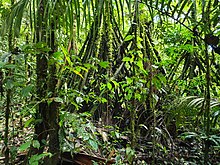
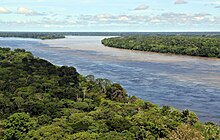
The rainforest likely formed during the
Following the

During the
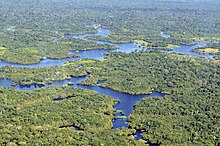
There is evidence that there have been significant changes in the Amazon rainforest
Sahara Desert dust windblown to the Amazon
More than 56% of the dust fertilizing the Amazon rainforest comes from the
NASA's CALIPSO satellite has measured the amount of dust transported by wind from the Sahara to the Amazon: an average of 182 million tons of dust are windblown out of the Sahara each year, at 15 degrees west longitude, across 2,600 km (1,600 mi) over the Atlantic Ocean (some dust falls into the Atlantic), then at 35 degrees West longitude at the eastern coast of South America, 27.7 million tons (15%) of dust fall over the Amazon basin (22 million tons of it consisting of phosphorus), 132 million tons of dust remain in the air, 43 million tons of dust are windblown and falls on the Caribbean Sea, past 75 degrees west longitude.[41]
CALIPSO uses a laser range finder to scan the Earth's atmosphere for the vertical distribution of dust and other aerosols. CALIPSO regularly tracks the Sahara-Amazon dust plume. CALIPSO has measured variations in the dust amounts transported – an 86 percent drop between the highest amount of dust transported in 2007 and the lowest in 2011.
A possibility causing the variation is the Sahel, a strip of semi-arid land on the southern border of the Sahara. When rain amounts in the Sahel are higher, the volume of dust is lower. The higher rainfall could make more vegetation grow in the Sahel, leaving less sand exposed to winds to blow away.[42]
Amazon phosphorus also comes as smoke due to biomass burning in Africa.[43][44]
Biodiversity, flora and fauna
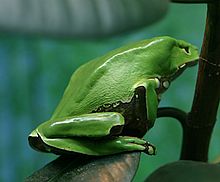
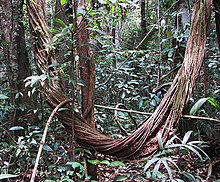
Wet tropical forests are the most species-rich biome, and tropical forests in the Americas are consistently more species rich than the wet forests in Africa and Asia.[45] As the largest tract of tropical rainforest in the Americas, the Amazonian rainforests have unparalleled biodiversity. One in ten known species in the world lives in the Amazon rainforest.[46] This constitutes the largest collection of living plants and animal species in the world.[47]
The region is home to about 2.5 million insect species,[48] tens of thousands of plants, and some 2,000 birds and mammals. To date, at least 40,000 plant species,[49] 2,200 fishes,[50] 1,294 birds, 427 mammals, 428 amphibians, and 378 reptiles have been scientifically classified in the region.[51] One in five of all bird species are found in the Amazon rainforest, and one in five of the fish species live in Amazonian rivers and streams. Scientists have described between 96,660 and 128,843 invertebrate species in Brazil alone.[52]
The biodiversity of plant species is the highest on Earth with one 2001 study finding a quarter square kilometer (62 acres) of Ecuadorian rainforest supports more than 1,100 tree species.[53] A study in 1999 found one square kilometer (247 acres) of Amazon rainforest can contain about 90,790 tonnes of living plants. The average plant biomass is estimated at 356 ± 47 tonnes per hectare.[54] To date, an estimated 438,000 species of plants of economic and social interest have been registered in the region with many more remaining to be discovered or catalogued.[55] The total number of tree species in the region is estimated at 16,000.[4]
The green leaf area of plants and trees in the rainforest varies by about 25% as a result of seasonal changes. Leaves expand during the dry season when sunlight is at a maximum, then undergo abscission in the cloudy wet season. These changes provide a balance of carbon between photosynthesis and respiration.[56]
Each hectare of the Amazon rainforest contains around 1 billion of invertebrates. The amount of species per hectare in the Amazon rainforest can be presented in the next table:[57]
| Type of organism | Number of species per hectare |
|---|---|
| Birds | 160 |
| Trees | 310 |
| Epiphytes | 96 |
| Reptile | 22 |
| Amphibians | 33 |
| Fish | 44 |
| Primates | 10 |
The rainforest contains several species that can pose a hazard. Among the largest predatory creatures are the
The biodiversity in the Amazon is becoming increasingly threatened, primarily by habitat loss from deforestation as well as increased frequency of fires. Over 90% of Amazonian plant and vertebrate species (13,000–14,000 in total) may have been impacted to some degree by fires.[60]
-
Bullet ants have an extremely painful sting
-
Parrots at clay lick inYasuni National Park, Ecuador
-
Pipa pipa, a species of frog found within the Amazon.
-
Scarlet macaw, indigenous to the American tropics.
Deforestation
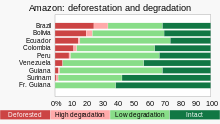
Prior to the early 1960s, access to the forest's interior was highly restricted, and the forest remained basically intact.
In the 1970s, construction began on the
Between 1991 and 2000, the total area of forest lost in the Amazon rose from 415,000 to 587,000 km2 (160,000 to 227,000 sq mi), with most of the lost forest becoming pasture for cattle.[72] Seventy percent of formerly forested land in the Amazon, and 91% of land deforested since 1970, have been used for livestock pasture.[73][74] Currently, Brazil is the largest global producer of soybeans. New research however, conducted by Leydimere Oliveira et al., has shown that the more rainforest is logged in the Amazon, the less precipitation reaches the area and so the lower the yield per hectare becomes. So despite the popular perception, there has been no economical advantage for Brazil from logging rainforest zones and converting these to pastoral fields.[75]

The needs of soy farmers have been used to justify many of the controversial transportation projects that are currently developing in the Amazon. The first two highways successfully opened up the rainforest and led to increased settlement and deforestation. The mean annual deforestation rate from 2000 to 2005 (22,392 km2 or 8,646 sq mi per year) was 18% higher than in the previous five years (19,018 km2 or 7,343 sq mi per year).[76] Although deforestation declined significantly in the Brazilian Amazon between 2004 and 2014, there has been an increase to the present day.[77]

Brazil's President, Jair Bolsonaro, has supported the relaxation of regulations placed on agricultural land. He has used his time in office to allow for more deforestation and more exploitation of the Amazon's rich natural resources.
Since the discovery of fossil fuel reservoirs in the Amazon rainforest, oil drilling activity has steadily increased, peaking in the Western Amazon in the 1970s and ushering another drilling boom in the 2000s.[78] Oil companies have to set up their operations by opening new roads through the forests, which often contributes to deforestation in the region.[79]
The
According to a November 2021 report by Brazil's INPE, based on satellite data, deforestation has increased by 22% over 2020 and is at its highest level since 2006.[82][83]
2019 fires
There were 72,843 fires in Brazil in 2019, with more than half within the Amazon region.[84][85][86] In August 2019 there were a record number of fires.[87] Deforestation in the Brazilian Amazon rose more than 88% in June 2019 compared with the same month in 2018.[88]
-
NASA satellite observation of deforestation in the Mato Grosso state of Brazil. The transformation from forest to farm is evident by the paler square shaped areas under development.
-
Fires and deforestation in the state of Rondônia
-
One consequence of forest clearing in the Amazon: thick smoke that hangs over the forest
-
Impact of deforestation on natural habitat of trees
The increased area of fire-impacted forest coincided with a relaxation of environmental regulations from the Brazilian government. Notably, before those regulations were put in place in 2008 the fire-impacted area was also larger compared to the regulation period of 2009–2018. As these fire continue to move closer to the heart of the Amazon basin, their impact on biodiversity will only increase in scale, as the cumulative fire-impacted area is correlated with the number of species impacted.[60]
Conservation and climate change

Environmentalists are concerned about
One
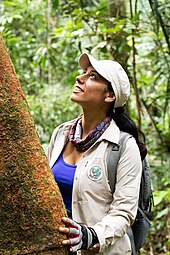
In 1989, environmentalist C.M. Peters and two colleagues stated there is economic as well as biological incentive to protecting the rainforest. One hectare in the

As indigenous territories continue to be destroyed by deforestation and
From 2002 to 2006, the conserved land in the Amazon rainforest almost tripled and deforestation rates dropped up to 60%. About 1,000,000 km2 (250,000,000 acres) have been put onto some sort of conservation, which adds up to a current amount of 1,730,000 km2 (430,000,000 acres).[99]
In April 2019, the Ecuadorian court stopped oil exploration activities in 180,000 hectares (440,000 acres) of the Amazon rainforest.[100]
In July 2019, the Ecuadorian court forbade the government to sell territory with forests to oil companies.[101]
In September 2019, the US and Brazil agreed to promote private-sector development in the Amazon. They also pledged a $100m biodiversity conservation fund for the Amazon led by the private sector. Brazil's foreign minister stated that opening the rainforest to economic development was the only way to protect it.[102]
-
Anthropogenic emission of greenhouse gases broken down by sector for the year 2000.
-
Aerosols over the Amazon each September for four burning seasons (2005 through 2008). The aerosol scale (yellow to dark reddish-brown) indicates the relative amount of particles that absorb sunlight.
-
Aerial roots of red mangrove on an Amazonian river.
-
Climate change disturbances of rainforests.[103]
A 2009 study found that a 4 °C rise (above pre-industrial levels) in global temperatures by 2100 would kill 85% of the Amazon rainforest while a temperature rise of 3 °C would kill some 75% of the Amazon.[104]

A new study by an international team of environmental scientists in the Brazilian Amazon shows that protection of freshwater biodiversity can be increased by up to 600% through integrated freshwater-terrestrial planning .[105]
Deforestation in the Amazon rainforest region has a negative impact on local climate.[106] It was one of the main causes of the severe drought of 2014–2015 in Brazil.[107][108] This is because the moisture from the forests is important to the rainfall in Brazil, Paraguay and Argentina. Half of the rainfall in the Amazon area is produced by the forests.[109]
Results of a 2021
In 2022 the supreme court of Ecuador decided that ""under no circumstances can a project be carried out that generates excessive sacrifices to the collective rights of communities and nature." It also required the government to respect the opinion of Indigenous peoples of the Americas about different industrial projects on their land. Advocates of the decision argue that it will have consequences far beyond Ecuador. In general, ecosystems are in better shape when indigenous peoples own or manage the land.[112]
Due to the conservation policies of Luiz Inácio Lula da Silva in the first 10 months of 2023 deforestation in the Brazilian Amazon decreased by around 50% compared to the same period in 2022. This was despite a severe drought, one of the worst on record, that exacerbated the situation. Climate change, El Nino, deforestation increases the likelihood of drought condition in the Amazon.[113]
According to Amazon Conservation's MAAP forest monitoring program, the deforestation rate in the Amazon from the 1 January to 8 November 2023 decreased by 56% in comparison to the same period in 2022. The main cause is the decline in deforestation rate in Brazil, due to the government's policies, while Columbia, Peru and Bolivia also reduced deforestation.[114]
In January 2024 published data showed a 50% decline in deforestation rate in the Amazon rainforest and 43% rise in vegetation loss in the neighbor Cerrado during the year of 2023 in comparison to 2022. Both biomes together lose 12,980 km², 18% less than in 2022.[115]
Remote sensing
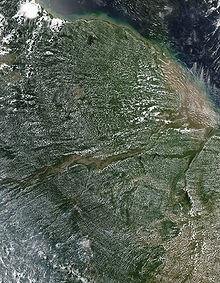
The use of remotely sensed data is dramatically improving conservationists' knowledge of the Amazon basin. Given the objectivity and lowered costs of satellite-based land cover and -change analysis, it appears likely that remote sensing technology will be an integral part of assessing the extents, locations and damage of deforestation in the basin.[116] Furthermore, remote sensing is the best and perhaps only possible way to study the Amazon on a large scale.[117]
The use of remote sensing for the conservation of the Amazon is also being used by the indigenous tribes of the basin to protect their tribal lands from commercial interests. Using handheld GPS devices and programs like Google Earth, members of the Trio Tribe, who live in the rainforests of southern Suriname, map out their ancestral lands to help strengthen their territorial claims.[118] Currently, most tribes in the Amazon do not have clearly defined boundaries, making it easier for commercial ventures to target their territories.
To accurately map the Amazon's biomass and subsequent carbon-related emissions, the classification of tree growth stages within different parts of the forest is crucial. In 2006, Tatiana Kuplich organized the trees of the Amazon into four categories: mature forest, regenerating forest [less than three years], regenerating forest [between three and five years of regrowth], and regenerating forest [eleven to eighteen years of continued development].
Impact of early 21st-century Amazon droughts
In 2005, parts of the Amazon basin experienced the worst drought in one hundred years,
According to the World Wide Fund for Nature, the combination of climate change and deforestation increases the drying effect of dead trees that fuels forest fires.[127]
In 2010, the Amazon rainforest experienced another severe drought, in some ways more extreme than the 2005 drought. The affected region was approximately 3,000,000 km2 (1,160,000 sq mi) of rainforest, compared with 1,900,000 km2 (734,000 sq mi) in 2005. The 2010 drought had three epicenters where vegetation died off, whereas in 2005, the drought was focused on the southwestern part. The findings were published in the journal Science. In a typical year, the Amazon absorbs 1.5 gigatons of carbon dioxide; during 2005 instead 5 gigatons were released and in 2010 8 gigatons were released.[128][129] Additional severe droughts occurred in 2010, 2015, and 2016.[130]
In 2019 Brazil's protections of the Amazon rainforest were slashed, resulting in a severe loss of trees.[131] According to Brazil's National Institute for Space Research (INPE), deforestation in the Brazilian Amazon rose more than 50% in the first three months of 2020 compared to the same three-month period in 2019.[132]
In 2020, a 17 percent rise was noted in the Amazon wildfires, marking the worst start to the fire season in a decade. The first 10 days of August 2020 witnessed 10,136 fires. An analysis of the government figures reflected 81 per cent increase in fires in federal reserves, in comparison with the same period in 2019.[133] However, President Jair Bolsonaro turned down the existence of fires, calling it a "lie", despite the data produced by his own government.[134] Satellites in September recorded 32,017 hotspots in the world's largest rainforest, a 61% rise from the same month in 2019.[135] In addition, October saw a huge surge in the number of hotspots in the forest (more than 17,000 fires are burning in the Amazon's rainforest) – with more than double the amount detected in the same month last year.[136]
Possibility of forest-friendly economy
In 2023 the World Bank, published a report named: "A Balancing Act for Brazil's Amazonian States: An Economic Memorandum". The report stating that economic losses due to deforestation in Brazil could reach around 317 billion dollars per year, approximately 7 times higher in comparison to the cost of all commodities produced through deforestation, proposed non-deforestation based economic program in the region of the Amazon rainforest.[6][7]
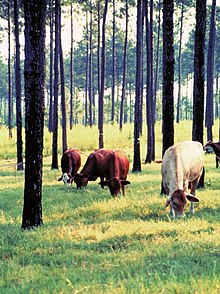
Silvopasture (integrating trees, forage and grazing) can help to stop deforestation in the region.[137]
According to WWF,
In May 2023 Brazil's bank federation decided to implement a new sustainability standard demanding from meatpackers to ensure their meat is not coming from illegally deforested area. Credits will not be given to those who will not meet the new standards. The decision came after the European Union decides to implement regulations to stop deforestation. Brazil beef exporters, said the standard is not just because it is not applied to land owners.[141] 21 banks representing 81% of the credit market in Brazil agree to follow those rules.[142]
According to a statement of the Colombian government deforestation rates in the Colombian Amazon fell by 70% in the first 9 months of 2023 compared to the same period in the previous year, what can be attributed to the conservation policies of the government. One of them is paying local residents for conserving the forest.[143]
See also
- Amanyé
- Atlantic Forest
- Bandeirantes
- Deforestation of the Amazon rainforest
- Environmental impact of meat production
- Forest protection
- Indigenous peoples in Brazil
- Tapiche Ohara's Reserve
- Organizations
- Technology
- Amazon Surveillance System (Sistema de Vigilância da Amazônia)
- Global Forest Watch
Notes
- ^ Portuguese: Floresta amazônica or Amazônia; Spanish: Selva amazónica, Amazonía, or usually Amazonia; French: Forêt amazonienne; Dutch: Amazoneregenwoud. In English, the names are sometimes capitalized further, as Amazon Rainforest, Amazon Forest, or Amazon Jungle.
- , descendants of Amazonian indigenous people and white Portuguese colonizers. Despite their indigenous ancestry, they no longer identify with any indigenous ethnicity.
References
- ^ "WWF – About the Amazon". Archived from the original on October 7, 2019. Retrieved October 11, 2019.
- ^ "Amazon River". britannica.com. Encyclopaedia Britannica. January 11, 2024.
- ^ "WNF: Places: Amazon". Archived from the original on April 13, 2020. Retrieved June 4, 2016.
- ^ a b "Field Museum scientists estimate 16,000 tree species in the Amazon". Field Museum. October 17, 2013. Archived from the original on December 7, 2019. Retrieved October 18, 2013.
- ^ "Inside the Amazon". Archived from the original on October 7, 2019. Retrieved November 5, 2020.
- ^ a b "World Bank: Brazil faces $317 billion in annual losses to Amazon deforestation". 8.9ha. World Bank. May 24, 2023. Retrieved May 30, 2023.
- ^ a b "A Balancing Act for Brazil's Amazonian States: An Economic Memorandum." Executive Summary booklet. The World Bank. 2023. Retrieved May 30, 2023.
- ^ ISBN 978-0-559-29668-0. Archivedfrom the original on July 25, 2020. Retrieved October 12, 2008.
- ^ "Yanomami". Encyclopaedia Britannica. Archived from the original on July 25, 2020. Retrieved June 20, 2020.
- S2CID 129231783.
- S2CID 7962308.
- S2CID 5316715.
- ^ "Remnants of Sprawling Ancient Cities Are Found in the Amazon". The New York Times. January 23, 2024. Retrieved January 30, 2024.
- ^ ISBN 978-0-415-06239-8. Archivedfrom the original on January 10, 2022. Retrieved August 24, 2017.
- PMID 26202998.
- ISBN 978-0-226-76337-8.
- ^ a b c "Unnatural Histories – Amazon". BBC Four. Archived from the original on January 8, 2020. Retrieved May 9, 2012.
- ^ Simon Romero (January 14, 2012). "Once Hidden by Forest, Carvings in Land Attest to Amazon's Lost World". The New York Times. Archived from the original on December 26, 2019. Retrieved February 26, 2017.
- S2CID 55741813.
- ^ Junior, Gonçalo (October 2008). "Amazonia lost and found". Pesquisa (Ed.220). Archived from the original on August 12, 2014.
- JSTOR 2803990.
- S2CID 7962308
- ^ "The Amazon's head hunters and body shrinkers". The Week. January 20, 2012. Archived from the original on October 13, 2018. Retrieved September 12, 2019.
- ^ Chagnon, Napoleon A. (1992). Yanomamo. New York: Holt, Rinehart, and Winston.
- ^ "Mundurukú people". britannica.com. Encyclopaedia Britannica.
- ^ La Republica Oligarchic. Editorial Lexus 2000 p. 925.
- ^ From the first expedition to the creation of the Park, pib.socioambiental.org
- ^ "Rain delays rescue of explorers". The Herald. Glasgow, Scotland. September 8, 1961. p. 8 – via Google News.
- ISBN 0-929292-86-3. Retrieved May 27, 2020.
- ^ Coca-Castro, Alejandro; Reymondin, Louis; Bellfield, Helen; Hyman, Glenn (January 2013), Land use Status and Trends in Amazonia (PDF), Amazonia Security Agenda Project, archived from the original (PDF) on March 19, 2016, retrieved August 25, 2019
- ISBN 978-0-471-98326-2.
- PMID 15519975.
- doi:10.1111/j.1475-5661.2005.00181.x. Archived from the original(PDF) on October 1, 2008. Retrieved September 25, 2008.
- ISBN 978-0-19-856706-6.
- .
- .
- .
- .
- .
- .
- ^ Garner, Rob (February 24, 2015). "Saharan Dust Feeds Amazon's Plants". NASA. Archived from the original on June 23, 2019. Retrieved June 20, 2019.
- ^ "Desert Dust Feeds Amazon Forests – NASA Science". nasa.gov. Archived from the original on May 14, 2017. Retrieved July 12, 2017.
- PMID 31358622.
- ^ "Smoke from Africa fertilizes the Amazon and tropical ocean regions with soluble phosphorous". phys.org. Archived from the original on August 14, 2019. Retrieved August 14, 2019.
- ISBN 0-521-80183-4[page needed]
- ^ "Amazon Rainforest, Amazon Plants, Amazon River Animals". World Wide Fund for Nature. Archived from the original on May 17, 2008. Retrieved May 6, 2008.
- ^ Weisberger, Mindy (March 26, 2024). "Ancient giant dolphin discovered in the Amazon". CNN. Retrieved March 29, 2024.
- ^ "Photos / Pictures of the Amazon Rainforest". Travel.mongabay.com. Archived from the original on December 17, 2008. Retrieved December 18, 2008.
- ^ "Rainforest". National Geographic.
- ^ James S. Albert; Roberto E. Reis (March 8, 2011). Historical Biogeography of Neotropical Freshwater Fishes. University of California Press. p. 308. Archived from the original on June 30, 2011. Retrieved June 28, 2011.
- S2CID 85843442.
- S2CID 84691981.
- S2CID 4863115.
- .
- ^ "Amazon Rainforest". South AmericaTravel Guide. Archived from the original on August 12, 2008. Retrieved August 19, 2008.
- PMID 17360360.
- ^ Costa, Camilla (May 21, 2020). "Amazon under threat: Fires, loggers and now virus". BBC. Retrieved November 14, 2023.
- ^ "Piranha 'less deadly than feared'". BBC News. July 2, 2007. Archived from the original on July 7, 2007. Retrieved July 2, 2007.
- PMID 16965697.
- ^ from the original on September 12, 2021. Retrieved September 11, 2021.
- ^ "Forest Pulse: The Latest on the World's Forests". WRI.org. World Resources Institute. April 28, 2022. Archived from the original on April 28, 2022. ● 2022 Global Forest Watch data quoted by McGrath, Matt; Poynting, Mark (June 27, 2023). "Climate change: Deforestation surges despite pledges". BBC. Archived from the original on June 29, 2023.
- ^ "Amazon Against the Clock: A Regional Assessment on Where and How to Protect 80% by 2025" (PDF). Amazon Watch. September 2022. p. 8. Archived (PDF) from the original on September 10, 2022.
Graphic 2: Current State of the Amazon by country, by percentage / Source: RAISG (Red Amazónica de Información Socioambiental Georreferenciada) Elaborated by authors.
- ISBN 978-0-300-08483-2.
- ^ a b Tandon, Ayesha (October 4, 2023). "Drying of Amazon could be early warning of 'tipping point' for the rainforest". Carbon Brief. Retrieved October 6, 2023.
- ^ "Amazon Rainforest 'heading to point of no return'". February 22, 2018. Archived from the original on September 22, 2020. Retrieved July 6, 2019.
- PMID 29492460.
- PMID 37792950.
- (PDF) from the original on July 22, 2018. Retrieved October 27, 2017.
- ^ a b Watkins and Griffiths, J. (2000). Forest Destruction and Sustainable Agriculture in the Brazilian Amazon: a Literature Review (Doctoral dissertation, The University of Reading, 2000). Dissertation Abstracts International, 15–17
- ISBN 978-0-226-89947-3.
- ^ "Impacts and Causes of Deforestation in the Amazon Basin". kanat.jsc.vsc.edu. Archived from the original on June 15, 2013. Retrieved March 6, 2013.
- ^ Centre for International Forestry Research (CIFOR) (2004)
- ISBN 978-92-5-105571-7. Archivedfrom the original on July 26, 2008. Retrieved August 19, 2008.
- ISBN 978-0-8213-5691-3. Archived (PDF) from the original on September 10, 2008. Retrieved September 4, 2008.)
{{cite book}}:|work=ignored (help - ^ "Research paper of Leydimere Oliveira on the amazon". Archived from the original on August 3, 2013.
- ^ Barreto, P.; Souza Jr. C.; Noguerón, R.; Anderson, A. & Salomão, R. 2006. Human Pressure on the Brazilian Amazon Forests[permanent dead link]. Imazon. Retrieved 28 September 2006. (The Imazon Archived September 1, 2004, at the Wayback Machine web site contains many resources relating to the Brazilian Amazonia.)
- ^ "INPE: Estimativas Anuais desde 1988 até 2009". inpe.br. Archived from the original on November 30, 2010. Retrieved November 3, 2010.
- ^ "Oil Drilling Contaminated Western Amazon". livesciences.com. June 13, 2014. Archived from the original on February 18, 2019. Retrieved February 17, 2019.
- ^ "Oil and Gas Extraction in the Amazon". wwf.panda.org. Archived from the original on February 18, 2019. Retrieved February 17, 2019.
- ^ "EU urged to halt trade talks with S. America over Brazil abuses". France 24. June 18, 2019. Archived from the original on August 25, 2019. Retrieved August 25, 2019.
- ^ "We must not barter the Amazon rainforest for burgers and steaks". The Guardian. July 2, 2019. Archived from the original on August 24, 2019. Retrieved August 25, 2019.
- ^ "Deforestation in Brazil's Amazon at highest level since 2006". Reuters/The Guardian. November 18, 2021. Archived from the original on November 18, 2021. Retrieved July 3, 2022.
- ^ "Brazil: Amazon sees worst deforestation levels in 15 years". BBC News. November 19, 2021. Archived from the original on July 15, 2022. Retrieved July 3, 2022.
- ^ "'Record number of fires' in Brazilian rainforest". BBC News Online. BBC Online. BBC. August 21, 2019. Archived from the original on August 22, 2019. Retrieved August 21, 2019.
- Turner Broadcasting System, Inc. Archivedfrom the original on August 14, 2020. Retrieved August 21, 2019.
- CBS Interactive Inc. Archivedfrom the original on August 27, 2019. Retrieved August 21, 2019.
- ^ "Record-breaking number of fires burn in Brazil's Amazon". CNBC. NBCUniversal. August 21, 2019. Archived from the original on July 25, 2020. Retrieved August 21, 2019.
- ^ "Brazil registers huge spike in Amazon deforestation". Deutsche Welle. July 3, 2019. Archived from the original on July 25, 2020. Retrieved August 22, 2019.
- S2CID 4370074.
- ^ (PDF) from the original on April 21, 2021.
- ^ Fox, Alex (March 26, 2021). "The Amazon Rainforest Now Emits More Greenhouse Gases Than It Absorbs". Smithsonian Magazine. Archived from the original on April 7, 2021. Retrieved April 8, 2021.
- ^ Katarina, Zimmer (August 28, 2019). "Why the Amazon doesn't really produce 20% of the world's oxygen". National Geographic. Archived from the original on February 18, 2021. Retrieved October 8, 2021.
- ^ Cox, Betts, Jones, Spall and Totterdell. 2000. "Acceleration of global warming due to carbon-cycle feedbacks in a coupled climate model" Archived August 18, 2020, at the Wayback Machine. Nature, 9 November 2000. (subscription required)
- ^ Radford, T. 2002. "World may be warming up even faster" Archived August 18, 2020, at the Wayback Machine. The Guardian.
- S2CID 253666282.
- Houghton, J.T. et al. 2001. "Climate Change 2001: The Scientific Basis" Archived 7 May 2006 at the Wayback Machine. Intergovernmental Panel on Climate Change.
- S2CID 4338510.
- ^ Dean, Bartholomew. (2003) State Power and Indigenous Peoples in Peruvian Amazonia: A Lost Decade, 1990–2000. In The Politics of Ethnicity Indigenous Peoples in Latin American States David Maybury-Lewis, Ed. Harvard University Press
- ^ Cormier, L. (April 16, 2006). "A Preliminary Review of Neotropical Primates in the Subsistence and Symbolism of Indigenous Lowland South American Peoples". Ecological and Environmental Anthropology. 2 (1): 14–32. Archived from the original on December 21, 2008. Retrieved September 4, 2008.
- ^ "Ecuador Amazon tribe win first victory against oil companies". Devdiscourse. April 27, 2019. Archived from the original on July 25, 2020. Retrieved April 28, 2019.
- ^ "Ecuador court rules Amazon rainforest can't be sold to oil companies". Newshub. Reuters. July 13, 2019. Archived from the original on July 19, 2019. Retrieved July 19, 2019.
- ^ "US and Brazil agree to Amazon development". BBC. September 14, 2019. Archived from the original on March 7, 2021. Retrieved September 15, 2020.
- ^ .
- ^ David Adam (March 11, 2009). "Amazon could shrink by 85% due to climate change, scientists say". The Guardian. Archived from the original on April 14, 2020. Retrieved December 11, 2016.
- S2CID 222080850. Archived from the original(PDF) on July 15, 2021.
- PMID 32064324.
- ^ Watts, Jonathan (November 28, 2017). "The Amazon effect: how deforestation is starving São Paulo of water". The Guardian. Archived from the original on June 7, 2020. Retrieved November 8, 2018.
- ^ Verchot, Louis (January 29, 2015). "The science is clear: Forest loss behind Brazil's drought". Center for International Forestry Research (CIFOR). Archived from the original on August 9, 2020. Retrieved November 8, 2018.
- PMID 29492460.
- ^ Fox, Alex. "The Amazon Rainforest Now Emits More Greenhouse Gases Than It Absorbs". Smithsonian Magazine. Archived from the original on April 7, 2021. Retrieved April 19, 2021.
- from the original on July 15, 2021. Retrieved July 15, 2021.
- ^ Einhorn, Catrin (February 4, 2022). "Ecuador Court Gives Indigenous Groups a Boost in Mining and Drilling Disputes". The New York Times. The New York Times. Archived from the original on February 6, 2022. Retrieved February 6, 2022.
- ^ "Deforestation in the Brazilian Amazon falls 22% in 2023". Mongabay. November 11, 2023. Retrieved November 13, 2023.
- ^ Spring, Jake (November 29, 2023). "Climate boost: 2023 Amazon deforestation drops 55.8%, study finds". The NRI Nation. Reuters. Retrieved December 3, 2023.
- ^ "Deforestation in Brazilian Amazon halved in 2023". Phys.org. Retrieved January 9, 2024.
- S2CID 128603494. Archived from the originalon December 21, 2008. Retrieved September 4, 2008.
- S2CID 31023189.
- ISSN 1059-1028. Retrieved August 11, 2023.
- .
- ^ "Amazon Drought Worst in 100 Years". www.ens-newswire.com. Archived from the original on November 15, 2019. Retrieved July 25, 2006.
- ^ Drought Threatens Amazon Basin – Extreme conditions felt for second year running Archived May 11, 2020, at the Wayback Machine, Paul Brown, The Guardian, 16 July 2006. Retrieved 23 August 2014
- ^ "Amazon rainforest 'could become a desert'" Archived 6 August 2006 at the Wayback Machine, The Independent, 23 July 2006. Retrieved 28 September 2006.
- ^ "Dying Forest: One year to save the Amazon" Archived September 25, 2015, at the Wayback Machine, The Independent, 23 July 2006. Retrieved 23 August 2014.
- PMID 29492460.
- ^ Stockholm Resilience Centre (October 5, 2020). "40% of Amazon could now exist as rainforest or savanna-like ecosystems". phys.org. Archived from the original on October 8, 2020. Retrieved October 6, 2020.
- S2CID 247255222.
- ^ "Climate change a threat to Amazon rainforest, warns WWF" Archived June 14, 2020, at the Wayback Machine, World Wide Fund for Nature, 22 March 2006. Retrieved 23 August 2014.
- ^ 2010 Amazon drought record: 8 Gt extra CO2 Archived March 27, 2019, at the Wayback Machine, Rolf Schuttenhelm, Bits Of Science, 4 February 2011. Retrieved 23 August 2014
- ^ "Amazon drought 'severe' in 2010, raising warming fears" Archived April 15, 2016, at the Wayback Machine, BBC News, 3 February 2011. Retrieved 23 August 2014
- ^ Abraham, John (August 3, 2017). "Study finds human influence in the Amazon's third 1-in-100 year drought since 2005". The Guardian. Archived from the original on October 31, 2019. Retrieved August 8, 2017.
- ^ Casado, Letícia; Londoño, Ernesto (July 28, 2019). "Under Brazil's Far Right Leader, Amazon Protections Slashed and Forests Fall". The New York Times. Archived from the original on August 18, 2020. Retrieved July 28, 2019.
- ^ "Scientists fear deforestation, fires and Covid-19 could create a 'perfect storm' in the Amazon". CNN. June 19, 2020. Archived from the original on July 25, 2020. Retrieved June 20, 2020.
- ^ "Brazil experiences worst start to Amazon fire season for 10 years". The Guardian. August 13, 2020. Archived from the original on August 14, 2020. Retrieved August 13, 2020.
- ^ "Brazil's Bolsonaro calls surging Amazon fires a 'lie'". Reuters. August 11, 2020. Archived from the original on August 12, 2020. Retrieved August 11, 2020.
- ^ "Brazil's Amazon rainforest suffers worst fires in a decade". The Guardian. October 1, 2020. Archived from the original on October 2, 2020. Retrieved October 2, 2020.
- ^ "Campaigners' anger after huge surge in rainforest blazes". Sky News. Archived from the original on November 7, 2020. Retrieved November 5, 2020.
- ^ "Silvopasture could tackle Colombian Amazon's high deforestation rates and help achieve COP26 targets". Phys.org. University of Bristol. Retrieved May 30, 2023.
- ^ "Ecotourism could help the Amazon reduce deforestation and handle climate change". Archived from the original on May 18, 2021. Retrieved May 18, 2021.
- ^ "Community-Based Ecotourism in the Mamirauá Reserve: evaluation of product quality and reflections regarding the economic and financial feasibility of the activity". Retrieved March 19, 2022.
- ^ "Our ecolodges". Archived from the original on May 18, 2021. Retrieved May 18, 2021.
- ^ FREITAS, TATIANA. "Brazilian banks are denying credit to meatpackers that deal in beef illegally raised in the Amazon rainforest". Fortune. Retrieved June 1, 2023.
- ^ Ziolla Menezes, Fabiane (May 30, 2023). "BNDES to join anti-deforestation effort from banks". The Brazilian Report. Retrieved June 1, 2023.
- ^ "Deforestation in Colombia Down 70 Percent So Far This Year". Yale Environment 360. Retrieved November 13, 2023.
Further reading
- Bunker, S.G. (1985). Underdeveloping the Amazon: Extraction, Unequal Exchange, and the Failure of the Modern State. University of Illinois Press.
- Cleary, David (2000). "Towards an Environmental History of the Amazon: From Pre-history to the Nineteenth Century". Latin American Research Review. 36 (2): 64–96. PMID 18524060.
- Dean, Warren (1976). Rio Claro: A Brazilian Plantation System, 1820–1920. Stanford University Press.
- Dean, Warren (1997). Brazil and the Struggle for Rubber: A Study in Environmental History. Cambridge University Press.
- Goulding, Michael (2021). The Fishes and the Forest: Explorations in Amazonian Natural History. Berkeley, CA: University of California Press. ISBN 9780520316126.
- Hecht, Susanna and Alexander Cockburn (1990). The Fate of the Forest: Developers, Destroyers, and Defenders of the Amazon. New York: Harper Perennial.
- Hochstetler, K. and M. Keck (2007). Greening Brazil: Environmental Activism in State and Society. Duke University Press. ISBN 978-0822340317
- Revkin, A. (1990). The Burning Season: The Murder of Chico Mendes and the Fight for the Amazon Rain Forest. Houghton Mifflin. ISBN 9780002158862
- Wade, Lizzie (2015). "Drones and satellites spot lost civilizations in unlikely places". Science News. .
- Weinstein, Barbara (1983). The Amazon Rubber Boom 1850–1920. Stanford University Press. ISBN 0804711682
- Sheil, D.; Wunder, S. (2002). "The value of tropical forest to local communities: complications, caveats, and cautions" (PDF). Conservation Ecology. 6 (2): 9. hdl:10535/2768. Archived(PDF) from the original on January 24, 2021. Retrieved September 25, 2019.
External links
- Journey into Amazonia
- The Amazon: The World's Largest Rainforest
- WWF in the Amazon rainforest
- Amazonia.org.br Good daily updated Amazon information database on the web, held by Friends of The Earth – Brazilian Amazon.
- Seasons in the Amazon and river levels Archived May 2, 2023, at the Wayback Machine
- amazonia.org Sustainable Development in the Extractive Reserve of the Baixo Rio Branco – Rio Jauaperi – Brazilian Amazon.
- Amazon Rainforest News Original news updates on the Amazon.
- Amazon-Rainforest.org Information about the Amazon rainforest, its people, places of interest, and how everyone can help.
- Conference: Climate change and the fate of the Amazon. Podcasts of talks given at Oriel College, University of Oxford, 20–22 March 2007.
- Dead humpback whale calf in the Amazon

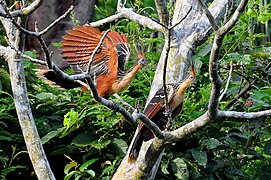



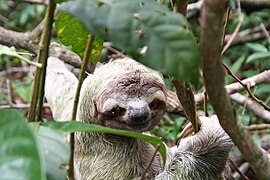
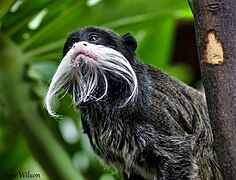


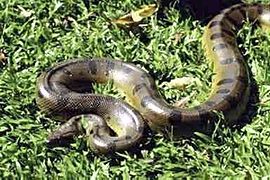




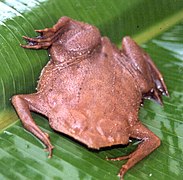
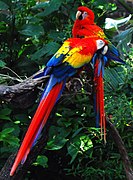






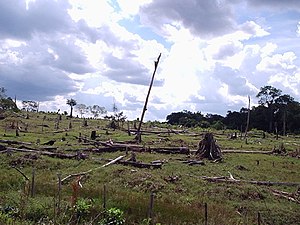



![Climate change disturbances of rainforests.[103]](http://upload.wikimedia.org/wikipedia/commons/thumb/1/1b/Climate_change_disturbances_of_rainforests_infographic.jpg/223px-Climate_change_disturbances_of_rainforests_infographic.jpg)